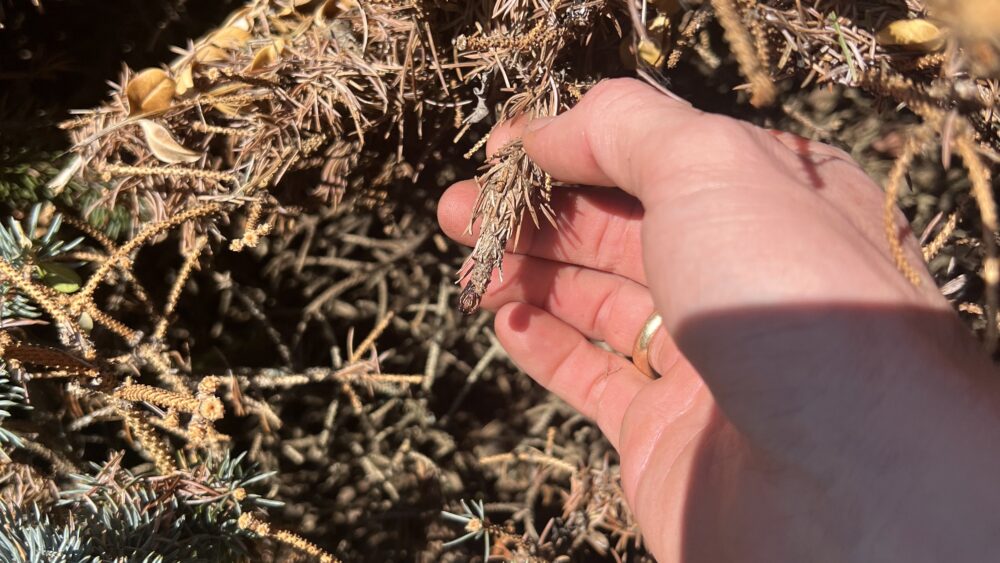Bagworms can destroy conifers with their enormous appetites for foliage. The insects lay hundreds of eggs every year and spread rapidly. Call Rick’s PHC Certified Arborists at 610-840-2655 to find out how you can prevent them from killing your trees.
What Are Bagworms?
Bagworms are insect larvae (caterpillars) from the species Thyridopteryx ephemeraeformis. They grow from one-quarter inch long to nearly two inches throughout the season as they feed on needles and leaves. They are unique because they spend their entire larval period in a brown silk “bag” that protects them as they feed.
Bagworms pose a special danger to conifers like red cedar, juniper, pine, spruce, and arborvitae, but they also attack other types of trees. Call Rick’s PHC Certified Arborists at 610-840-2655 to learn how to protect your trees from this pest and treat infestations.
Signs of Bagworm Infestation
If your tree has Bagworms, you will notice that it has taken great damage from hungry insects. Bagworms frequently defoliate trees, which weakens them and ruins their appearance.
The telltale sign of a Bagworm problem is finding small, brown bags attached to your trees, about 1 to 2 inches long. Some observers liken these bags to Christmas ornaments. The bags often have needles stuck to the outside, making them difficult to spot against the color of the branches.
Insect Control
To control Bagworms on small trees and shrubs, you can pick the bags off the plants before they hatch. You may need to use a knife. Rather than discarding these bags in the woods, put them in the trash so they will not reinfest your trees.
Several different commercial insecticide preparations can kill Bagworms. The right time to spray is in the first part of June. A Certified Arborist can apply an insecticide if there are too many bags to pick. Pheromone traps that prevent the insects from mating may also be available.
Prevention
While preventing a bagworm infestation is difficult, you can stop it in its tracks by applying pesticides early in the year, as described above. Pick as many bags as possible in the off-season to prevent the worms from hatching in the late spring. Ensure you apply the pesticides to the worms while they are still small.
Are You a Good Candidate for Bagworm Treatment?
Bagworms threaten conifers, but you can control them using the right methods. If you have noticed any sign of Bagworms, starting treatment early in the year is important. Ideally, treat Bagworm infestations before the larvae grow large. Even if you have an advanced Bagworm problem, a Certified Arborist will be able to help you control it and save your valuable trees.
Why Choose Rick’s PHC Certified Arborists?
Certified Arborists have special knowledge and skills to diagnose and treat insect and disease problems and other tree and shrub issues. We have extensive experience with Bagworms and know the best ways to combat this common and destructive pest.
Frequently Asked Questions About Bagworms
Is the Bagworm a moth?
Yes, the Bagworm is a moth caterpillar. The adult female Bagworm does not metamorphose into a worm. It is a soft-bodied yellow worm resembling a maggot. The females never leave their bags but instead lay their eggs inside and die. The adult male Bagworm becomes a furry, black moth after metamorphosis.
Do Bagworms have any natural predators?
Wasps and birds can be encouraged to eat Bagworms. To attract wasps, place flowering plants near the infested trees. Sparrows and finches also eat Bagworms. Placing seeds, roosting shrubs, and fruit-bearing plants in the area attracts them.
Can Bagworms kill a tree?
In great enough numbers, hungry Bagworms can defoliate trees to the point where they do not survive. Repeated infestations are most likely to kill a tree if it cannot regenerate lost foliage.
How do Bagworms spread from tree to tree?
Bagworms use a “ballooning” technique to move from tree to tree. They spin a thread of silk and use it to float across to another tree.
Are stressed trees more vulnerable to Bagworm infestation?
If a tree is already under stress, it attracts insects and diseases. A weakened tree may be more likely to die and less able to regrow its foliage if Bagworms attack it.
Why are Bagworm moths uncommon to find in the woods?
The adult male Bagworm moth lives only a few days after mating, so many people have not seen them in the wild.
Call Rick’s Plant Health Care
Bagworms may be dangerous to conifers, but you can control them. Call Rick’s PHC Certified Arborists at 610-840-2655 to find out what you can do to protect your trees from destructive Bagworms.


Comments are closed.